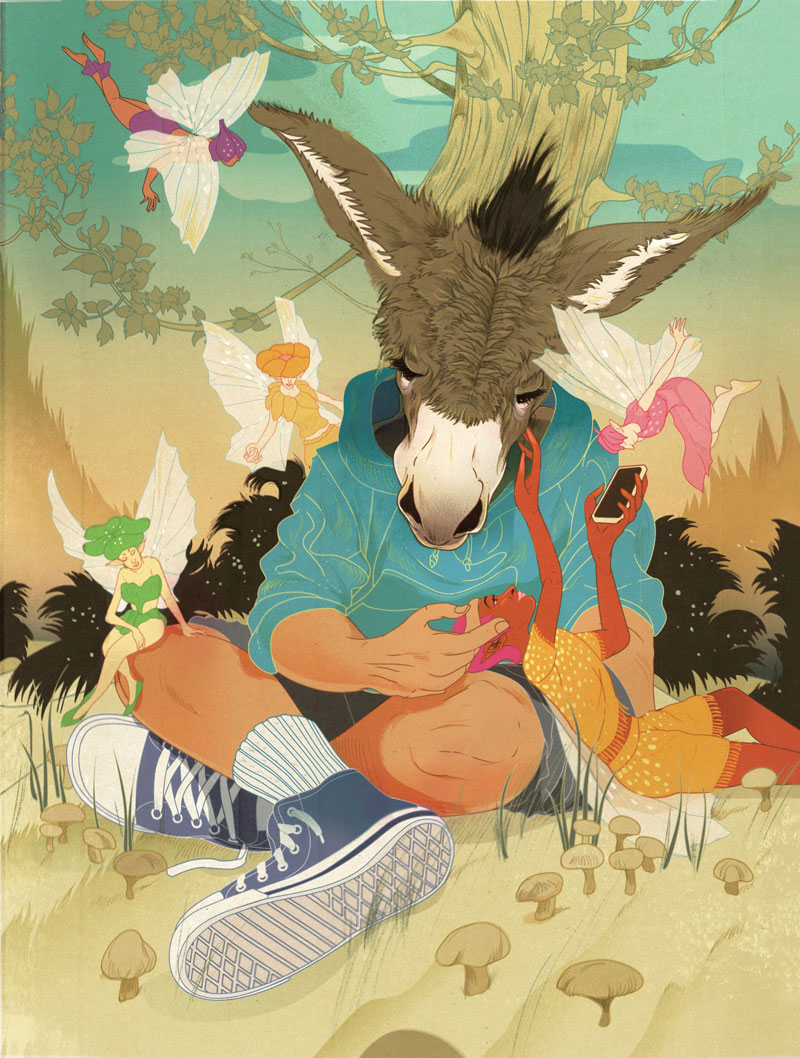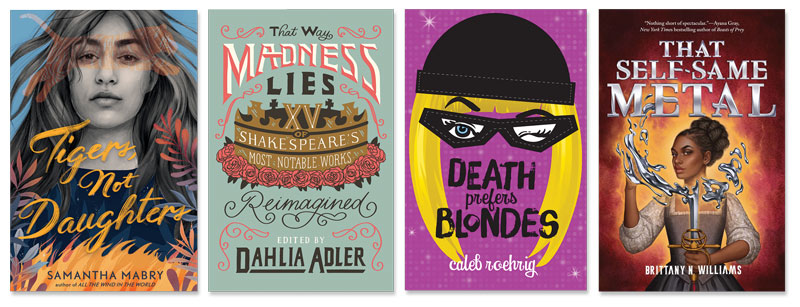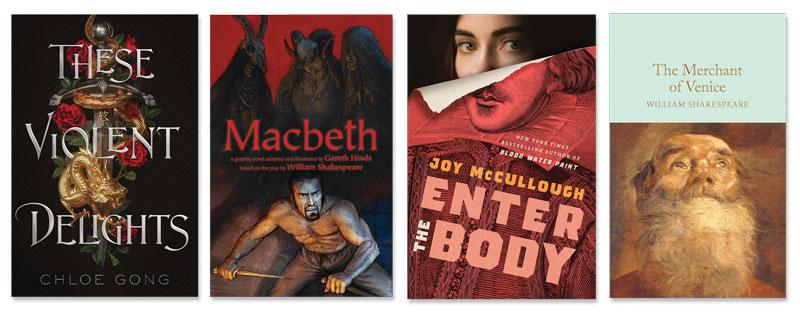After 400 Years, Shakespeare’s Plays Hold Strong Teen Appeal
Whether for witty wordplay, star-crossed love stories, or bloody history, the Bard's plays still inspire—in particular, they inspire YA adaptations.
 |
Illustration and SLJ November 2023 Cove by Marcos Chin |
Related reading:Much Ado About AI: Why I Built a Tool to Modernize Shakespeare’s Verse |
Cruel despots, doomed romance, bawdy banter. They’ve been part of William Shakespeare’s world from the start, as have moral objection to and censorship of the Bard’s plays. Consider the time, in the 1590s, that the playwright allegedly was forced to cut a scene from Richard II for fear it would incite political revolt. More recently, objectors have wondered if Shakespeare is too canonical and if his language is too arcane to be foisted upon 21st-century teenagers. Now, educators are asking, is his work too sexy for schools? Yes, some say. Gaither High School in Tampa, FL, will only teach excerpts of Shakespeare’s works this year.
There are good reasons Shakespeare’s plays survive all these assaults: unforgettable characters, over-the-top stagecraft, and universal stories. This year marks the 400th anniversary of the First Folio, the inaugural collected edition of Shakespeare’s plays. It was compiled seven years after his death by two of his friends, John Heminges and Henry Condell. Without it, several works would have been lost to history, as they were produced in an era when their primary purpose was live theater, not leisure reading.
Also read: 10 YA Novels Re-imagine Shakespeare Works
The First Folio has as storied a history as Shakespeare’s work itself. Every edition differs slightly, as copies were corrected as they were printed. Errors in one Folio differ from those in another. Between 750 and 1,000 copies of the First Folio were published in 1623, and some 235 survive today, most at the Folger Shakespeare Library in Washington, DC.
Blow off the dust, and Shakespeare’s works remain fresh and exciting to many writers and readers of young adult fiction. Whether for the witty wordplay, star-crossed love stories, bloody history, or dramaturgy, they enchant and inspire. In particular, they inspire YA adaptations.

Tapping into emotional response
 Among some long-standing Shakespeare YA retellings are Street Love by Walter Dean Myers and Romiette and Julio by Sharon M. Draper. Both take inspiration from Romeo and Juliet, still a staple of many high school literature classrooms.
Among some long-standing Shakespeare YA retellings are Street Love by Walter Dean Myers and Romiette and Julio by Sharon M. Draper. Both take inspiration from Romeo and Juliet, still a staple of many high school literature classrooms.
“There’s just a lot of appeal to working with texts that are so universally well known, where readers already have context,” says Dahlia Adler, an author and editor of That Way Madness Lies: 15 of Shakespeare’s Most Notable Works Reimagined. “You can get increasingly innovative with it because you’re not going to be writing the Romeo and Juliet.”
Because Shakespeare’s work was written for theater, emotional response from the audience was central. Theatrical success hinged on audience buy-in, and as the Bard’s work sought to reach a wide range of classes, from those who needed to stand at the show (the groundlings) to those in pricey seats, his work had to capture experiences across social and cultural barriers. The universality of themes in his plays is why they resonate with readers today, whether they have the historical context or knowledge of the original. YA retellings take the magic of this wide appeal to teens. Fresh spins on classic stories can draw in those with no interest in the originals along with readers who love a literary rabbit hole.
“There’s no doubt that Shakespeare is hard to understand sometimes,” says Chloe Gong, author of the "These Violent Delights" duology (a retelling of Romeo and Juliet set in 1920s Shanghai) and Foul Lady Fortune (a retelling of As You Like It, set in 1930s Shanghai). “For most teen readers, combining his thematic work with fresh writing makes for an appealing way to understand a good story. For the English nerds out there, Shakespeare’s work is timeless, and it’s fascinating to see one core story repackaged again and again to bring new appeal.”
Also read: To Teach or Not To Teach: Is Shakespeare Still Relevant to Today’s Students?
Caleb Roehrig agrees. The author of Death Prefers Blondes, a queer take on Hamlet, and the queer-themed Teach the Torches to Burn: A Romeo & Juliet Remix, notes that the combination of familiar themes with universal emotional experience makes Shakespeare’s work ripe for adaptation.
“You can move Richard III from 15th-century England to a contemporary private school for girls, and as long as it still tells the story of an abusive, power-hungry despot who succumbs to madness and paranoia, it passes the smell test,” says Roehrig. “What readers want—and what writers need—are for the emotional stakes to remain intact.”
Shakespeare was himself a reteller, as author Joy McCullough points out.
“Why did his Romeo and Juliet survive, rather than Arthur Brooke’s poem it was based on, ‘The Tragicall Historye of Romeus and Juliet?’” asks McCullough, whose book Enter the Body imagines some of Shakespeare’s tragic heroines telling their stories in their own words. “[Shakespeare] knew how to focus in on what would be most compelling to the audiences of his day.”

A variety of retellings
Writers like McCullough are fascinated with how emotional expressions and thematic explorations of Shakespeare can translate into other settings, with new characters and a wide range of genres.
McCullough’s Enter the Body, for example, does not just retell one of Shakespeare’s works. The multi-formatted story weaves together imagined voices of iconic characters Juliet, Cordelia, Ophelia, and Lavinia, who now have agency to tell their stories from a female point of view.
“I want Shakespeare adaptations to subvert the original story, experiment with form, or in some other way actively engage with and make fresh choices with the story,” McCullough says.
Because of their stage orientation, Shakespeare’s plays also lend themselves to visual storytelling—including in graphic novel format.
Visual artists such as Gareth Hinds, who has adapted Macbeth, Romeo and Juliet, The Merchant of Venice, and King Lear, find Shakespeare’s work appealing. Readers who struggle with the original text find graphic novels a more welcoming format, too.
“Graphic novels are a powerful way to level the playing field by not only making the story more accessible so kids can understand and participate in discussion, but also by allowing them dig deeper—to reread, to search for things like symbolism, emotion, and characterization in the images instead of just in the text,” says Hinds.
“The absolute best is when I hear from a parent or teacher that my book switched on a light in some kid’s brain and they discovered that they actually like literature.”
Stagecraft motivated Samantha Mabry to write Tigers, Not Daughters. She got a bolt of inspiration from the delivery of a single line at a King Lear performance.
“I remember being struck by the actor who played Lord Albany just spitting out this insult to Lear’s daughters that they were ‘tigers, not daughters,’” says Mabry. “To me this didn’t sound like an insult at all but sounded kind of cool.”
“Regan and Goneril are extremely hard-hearted and ruthless, but Lear isn’t exactly Father of the Year,” she adds. “I was inspired to explore the idea of daughter implying more than one worthy thing—obedient—and that maybe some fathers don’t deserve all the love and respect they may think they do.”
Mabry’s book is far from a straight King Lear retelling: it weaves in clever inspiration from Little Women, too. Such fresh spins echo the original while also becoming something entirely separate.
Author Brittany N. Williams is equally curious about the lives of those behind the scenes. Imagining the world in which Shakespeare’s troupe performed—and adding a little magic—resulted in Williams’s YA fantasy novel That Self-Same Metal. Inspired by both fae lore and A Midsummer Night’s Dream, Williams tells the story of a Black sword expert and craftswoman involved in the Bard’s stage company, the King’s Men.
“I wanted to blend the fresh and familiar,” Williams says. “The main character, Joan, and her twin brother, James, are based on twins Viola and Sebastian in Twelfth Night. James was also the name of an actual apprentice in Shakespeare’s acting company. I seeded things like that throughout to hopefully send folks down some fun Wikipedia wormholes.”

Better representation
As YA lit has grown to better represent the diversity of the world, so have Shakespearean adaptations. Shakespeare was no stranger to creating worlds with queer characters, but contemporary adaptations center these voices. They also center marginalized main characters, allowing inclusivity to play a starring role.
“[Shakespeare is] part of our canon and legacy and has been both held up as aspirational and used as a cudgel in the name of white supremacy,” says Williams. “That made me, as a Black writer, want to snatch his work off that false pedestal and make it something familiar to me and my folks.”
“Shakespeare is uniquely suited to inclusive adaptations because it’s uniquely suited to adaptations, period,” adds Roehrig.
Studying The Merchant of Venice in her Orthodox Jewish high school led Adler to realize how Shylock’s portrayal in the play impacted broader cultural views of Jewish people. His depiction as a villain—and the classification of the play as a comedy when, for Jewish people, it is often seen as a tragedy, she says—inspired her to think about the ways these stories can be remixed to allow readers of all backgrounds to see themselves in more nuanced ways.
“I really believe that with Shakespeare, there’s an inroad for anyone. The key is recognizing and appreciating that it isn’t going to be a positive inroad for everyone,” she adds. “If someone looks at Shakespeare and says, ‘I don’t see myself or my culture in that work,’ or ‘I see myself in that work, but strictly as a villain or caricature,’ that’s a connection to be explored, too, and that can be a difficult thing for Shakespeare fans to appreciate sometimes.”
Mabry agrees. “We’re allowed to both adore Shakespeare and also pooh-pooh some of his authorial moments.”
Adaptations provide an avenue for young readers to appreciate and analyze a canonical staple while also inquiring where, how, and why their experiences fit into those stories. The classroom benefits abound.
“I believe keeping Shakespeare in the school curriculum is so valuable—I love his work, obviously. But pairing his work with contemporary authors showing new perspectives, new cultures, and representing marginalized identities is critical for teenagers today to feel seen and understood,” says Gong. “Retellings are a perfect bridge between a very old canon [with] relevant and necessary stories that teenagers will want to read.”
After 400 years, pairing the original plays with modern adaptations just makes sense. Their themes resonate, but so does the humor, darkness, and romance. The history still reaches us on a human level. From Shakespeare lover to Shakespeare skeptic, there’s something out there for everyone.
Kelly Jensen is an editor at Book Riot and a former librarian.
RELATED
The job outlook in 2030: Librarians will be in demand
The job outlook in 2030: Librarians will be in demand
ALREADY A SUBSCRIBER? LOG IN
We are currently offering this content for free. Sign up now to activate your personal profile, where you can save articles for future viewing






Add Comment :-
Be the first reader to comment.
Comment Policy:
Comment should not be empty !!!